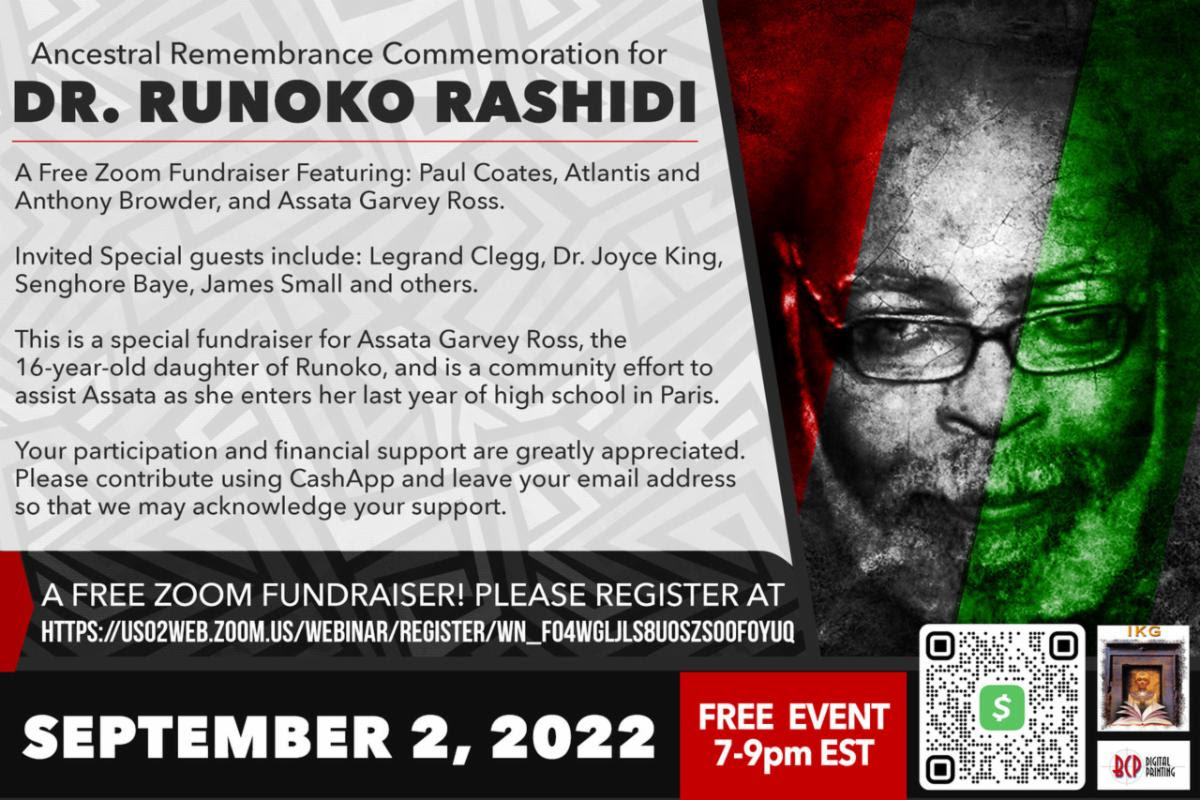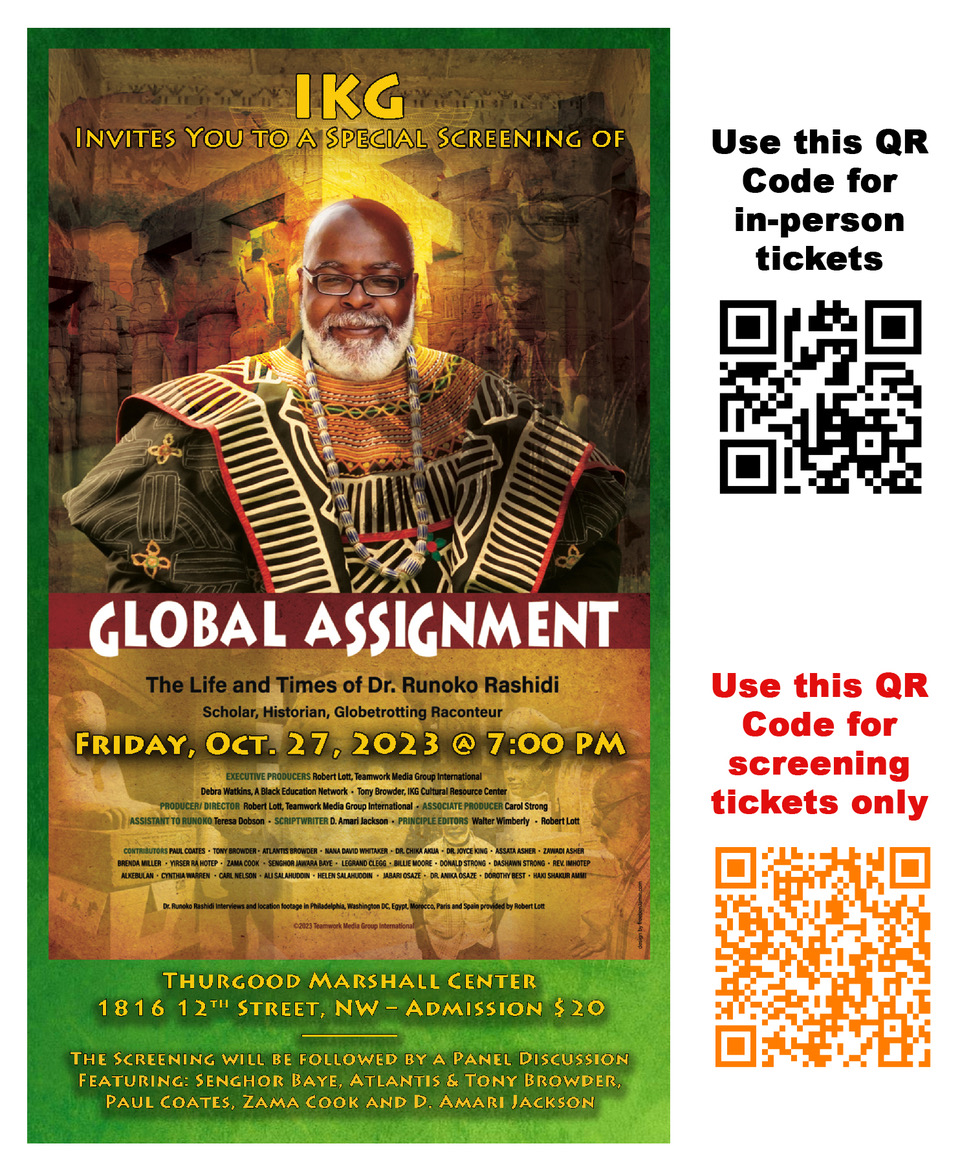- Forums
- BGOL Primary Forums
- Blackgirl Online
- Gone But Not Forgotten - R.I.P. Forum
- Celebrity R.I.P. Threads
You are using an out of date browser. It may not display this or other websites correctly.
You should upgrade or use an alternative browser.
You should upgrade or use an alternative browser.
Dr. Runoko Rashidi has died, his family announced the sad news that he has transitioned into the ancestral realm on August 2, 2021
- Thread starter World B Free
- Start date
They saying he just took
The vaccine required for
Travel to Africa
The vaccine required for
Travel to Africa
Rest in power.
RIP Dr. Runoko Rashidi.
R.I.P.
don't know how he escaped my knowledge or attention until his death, but RIP. Gonna do a deep dive...
i was really lookig forward to the trip not becos i necessarily needed a guide perse, but just that i could stand next to the man who taught me so much about black history and actually be in his presence in kemet watching & listening to him relive all the lessons id learnt from him in the flesh for just one time`



R.I.P.
RIP our brother
His knowledge of KMT/Aegyptus was thorough gotta give this brotha major props, once again may he RIP.
Rest well! Huge loss, we're fortunate to have what we do from the elder.
HAPI Film1 day ago (edited)
Family Please Support the Family of Dr. Runoko Rashidi. His sister Carol Strong is organizing funds and the only person authorized for the family to do so. Please support monetarily if you can!!!
I saw him on a couple late night PBS shows and the way he told them the truth, deliberately but without animosity was refreshing. RIP good doctor.
Rest in peace.
RIP
Topic
Ancestral Remembrance Gathering Honoring the Lives and Legacies of Dr. Runoko Rashidi, Dr. Frances Cress Welsing & Dr. Patricia Newton Zoom Fundraiser
Description
The Ancestral Remembrance Gathering is sponsored by Black Classic Press and IKG Cultural Circles. This event is a fundraiser for Assata Ross Garvey, the 16-year-old daughter of Runoko Rashidi. It is a community effort to assist Assata as she enters her last year of high school in Paris and prepares for college in 2023.
Featuring presentations by:
Anthony Browder
Atlantis Browder
Paul Coates
Assata Garvey Ross

 us02web.zoom.us
us02web.zoom.us

Ancestral Remembrance Gathering Honoring the Lives and Legacies of Dr. Runoko Rashidi, Dr. Frances Cress Welsing & Dr. Patricia Newton Zoom Fundraiser
Description
The Ancestral Remembrance Gathering is sponsored by Black Classic Press and IKG Cultural Circles. This event is a fundraiser for Assata Ross Garvey, the 16-year-old daughter of Runoko Rashidi. It is a community effort to assist Assata as she enters her last year of high school in Paris and prepares for college in 2023.
Featuring presentations by:
Anthony Browder
Atlantis Browder
Paul Coates
Assata Garvey Ross

Welcome! You are invited to join a webinar: Ancestral Remembrance Gathering Honoring the Lives and Legacies of Dr. Runoko Rashidi, Dr. Frances Cress Welsing & Dr. Patricia Newton Zoom Fundraiser. After registering, you will receive a confirmation email about joining the webinar.
The Ancestral Remembrance Gathering is sponsored by Black Classic Press and IKG Cultural Circles. This event is a fundraiser for Assata Ross Garvey, the 16-year-old daughter of Runoko Rashidi. It is a community effort to assist Assata as she enters her last year of high school in Paris and...

Remembering Dr. Runoko Rashidi: The Global Champion of African History
How A Meeting With Dr. Ivan Van Sertima In 1980 Launched A Global Assignment
Anthony BrowderSep 03, 2025

There will never be another scholar quite like Dr. Runoko Rashidi.
I had the privilege of calling this remarkable man my friend, colleague, and brother
Thanks for reading From The Browder File! Subscribe for free to receive new posts and support my work.

When people ask me about Runoko's legacy, I always tell them the same thing: he fulfilled an assignment that only he could complete. And he did it unlike anyone before him or after him.
That purpose was to document the global African presence.
Runoko visited over 130 countries in pursuit of his mission and he was the most traveled historian I knew.
I would frequently run into Runoko at conferences and occasionally in Egypt as our study groups crossed paths while visiting different monuments.
Two of my favorite memories of Runoko occurred in Africa:
- The first in 2010
- The second in 2016
My First Favorite Memory: Senegal 2010
In 2010, Runoko convened a conference in Dakar, Senegal, that was hosted by President Abdoulaye Wade and financed by President Muammar Gaddafi of Libya.President Wade hosted this gathering and invited 130 African-Americans to fly over on a chartered plane and he treated us all like royalty. I Watched Runoko preside over this assembly of African scholars. This was one of his greatest accomplishments and I was extremely proud to see him acknowledged by African leaders for his work.
This was a moment of true recognition.
My Second Favorite Memory: Sudan 2016
My second favorite memory of Runoko was in 2016 when I participated in a study tour of Sudan that he led.This was a life-changing trip for me because it allowed me to visit the homeland of the 25th dynasty priest whom I had been excavating for eight years.
The experience connected my research to the living land.

From Ronnie Ross to Dr. Runoko Rashidi
He was born Ronnie Ross on August 16, 1954, in Stockton, California, but became Runoko at 18 years old.Each part of his name comes from a different part of Africa and has a specific meaning.
- The name Runoko comes from the Shona community in Zimbabwe and means handsome
- Rashidi is Kiswahili, from Tanzania meaning counselor or teacher.
- Okalo, which means ‘He who brings’
His transformation from Ronnie to Runoko began in the 1970s when he encountered three pivotal influences:
- The teachings of Marcus Garvey - which opened his eyes to Pan-African consciousness
- Chancellor Williams' "Destruction of Black Civilization" - which showed him that African people had a history before enslavement
- A lecture by Stokely Carmichael - which crystallized his purpose and direction
The pivotal moment came in late 1980.
Runoko met Dr. Ivan Van Sertima at UCLA during a lecture about the African presence in pre-Columbian America. I know this story well because Van Sertima himself told me about that encounter—how this young man approached him with such passion and dedication that Van Sertima knew immediately he had found something special.

I had met Van Sertima myself three years earlier, on February 21st, 1977, at Georgetown Law School here in Washington DC. When he said that "the ancient Egyptians were black," it literally blew my mind. I had graduated from Howard in 1974 thinking I was smart, but hearing Van Sertima share those words with me transformed everything I thought I understood about African history.
That same transformation happened to Runoko in 1980.
By 1982, Runoko was writing for Van Sertima's Journal of African Civilizations. From 1982 to 1995, he contributed to every single issue—a remarkable consistency that showed his dedication to the work.
Their collaboration produced "The African Presence in Early Asia," which remains one of the most comprehensive examinations of African influence in early Asian civilizations.
This mentorship launched a career that would span six continents.
Documentation on a Scale Never Before Attempted
Runoko's approach to research was unlike anything I had encountered in academia.While most historians were content to work from their offices and libraries, Runoko was out there with his camera, notebook, and insatiable curiosity.
He visited over 85 museums worldwide, spoke in 67 countries, and documented African presence in places where mainstream scholarship insisted it never existed.
Only 49% of the US population have a passport, yet here was a brother systematically documenting African civilization across six continents.
What set him apart wasn't just his dedication—it was his understanding that African history couldn't be properly studied from a distance. You had to walk the same paths, touch the same stones, and connect with the same communities that maintained these traditions across millennia.
The scope of his documentation was staggering.
Teresa Dobson, a recent guest on The Browder File Show, worked as his administrative assistant. She described his archive as containing "thousands and thousands of original photos from virtually every major Egyptian collection in the world."
Runoko was the only person I know who systematically documented all 20 colossal African Olmec heads in Mexico, photographing each one over multiple annual tours.

He worked in India with Dalit communities in the 1980s and brought their leaders to speak in LA, Washington, and New York.

His documentation of Aboriginal-African connections in Australia.
He also conducted research on African presence in Russia, Vietnam, and Cambodia—this was scholarship on a scale that few could imagine, much less execute.
His Facebook page "In The Museums, Tombs, Galleries and Temples with Runoko Rashidi" became a virtual museum visited by thousands daily.

His Facebook page is still up and running with Teresa as the admin, and I encourage people to visit the page and scroll through those images. Each photograph represents hours of travel, research, and documentation that most scholars would never attempt.
This was documentation on a scale never before attempted by any historian, black or white.
Teresa is also keeping Runoko’s work alive through his Patreon page, while also working with Runoko’s sister and nephew to establish the Runoko Rashidi Institute.

Egypt: Where He Found His Purpose and His Peace
If you want to truely understand Runoko's mission, you had to understand his relationship with Egypt.For him, Egypt wasn't just another destination—it was the crown jewel of African civilization. He said:
"In Egypt you can see what African people did. And so therefore you have a sense of what African people are capable of."

He led countless tours through the monuments of the Nile Valley. He would point out features that other tour guides ignored or minimized:
- The African features carved in stone monuments
- The deliberate destruction of noses and lips on statues
- The evidence of advanced engineering and mathematics
- The spiritual and philosophical systems that influenced the world
His Final Journey
In August 2021, Runoko left for what we thought would be another research trip to Egypt.Usually, he would send his sisters detailed itineraries with hotel information and contact numbers. This time, he didn't. Maybe some part of him knew this journey would be different.
On 2nd of August 2021 Runoko transitioned to the ancestral realm.
But even in death, Runoko was exactly where he belonged.
He made his transition in Kemet, surrounded by the monuments of our ancestors. Perhaps the ancestors called him home.
Perhaps it was time for him to join the ranks of those he had spent his life studying and celebrating.
Honoring Runoko Through Film: Global Assignment
Two years after Runoko's passing, we completed one of the most important projects of my career.The documentary "Global Assignment: The Life and Times of Dr. Runoko Rashidi" represents our collective effort to ensure our brother's name lives forever.
As executive producer, I was inspired by Wesley Snipes' documentary "John Henrik Clark: A Great and Mighty Walk". That film captured the essence of one of my heroes in the year before he died, and I wanted our documentary to have the same transformative impact.

The title itself tells the story.
"Global Assignment" comes from Dr. Francis Cress Welsing's concept that every person was born with a cosmic assignment—something we came to this earth to do better than anyone else.
Runoko's cosmic assignment was crystal clear: to travel the globe and resurrect the global African presence for some, document it for others.
Robert Lot, our director, had traveled with Runoko to Egypt, Ghana, Morocco, and Paris. He possessed incredible footage that most people had never seen. But beyond Bob's material, we conducted new interviews with:
- Family members who knew him as Ronald Ross from Stockton
- Scholars who worked alongside him for decades
- Tour participants whose consciousness he transformed
- Community leaders who brought him to speak locally
- Publishing partners who helped spread his work
We couldn't include everything. We had to distill the essence of a man who devoted his life to African people and helped them understand their global presence.
The documentary serves multiple purposes that extend far beyond entertainment.
First, it preserves knowledge that's being actively erased.
Second, it inspires future generations to continue the mission:
Third, it demonstrates what one dedicated person can accomplish.
Runoko visited 130+ countries, documented 750,000+ photographs, and wrote 22 books—all as a self-trained historian from South Central LA.
What We Owe Him
Runoko used to challenge his audiences with a powerful question:"What will your statement in life be? How will future generations remember you?"
He would remind people that when we talk about historical figures who lived thousands of years ago—Imhotep, Thutmose III, Hannibal, Queen Nzinga—we speak of them as if they're still with us.
That's because their deeds were so significant that they achieved a kind of immortality.
Runoko Rashidi has joined that immortal company.
And every time we refuse to let our history be erased or diminished, Runoko's work continues.
So, as we commemorate Dr. Runoko Rashidi, I can truly say that I was proud to call him my friend and my brother.
I will always be grateful to the ancestors for allowing our spirits to cross paths during this lifetime.
Long live the spirit of Dr. Runoko Rashidi.

Thanks for reading.
Anthony Browder
Founder of IKG
Ps. If you want to find out more about the incredible life of Brother Runoko, you can get the Global Assignment documentary here
Thanks for reading From The Browder File! Subscribe for free to receive new posts and support my work.
Similar threads
- Replies
- 12
- Views
- 267
- Replies
- 3
- Views
- 125
- Replies
- 0
- Views
- 57
- Replies
- 2
- Views
- 65



